10 Space-Saving City Garden Ideas for Urban Dwellers
1. Vertical Herb Garden
Transform your kitchen wall into a functional herb garden using a pegboard system with attached pots. You’ll save valuable counter space while having fresh basil, mint, and rosemary within arm’s reach for cooking. This setup maximizes vertical space and brings greenery indoors where you need it most.
2. Hanging Basket Arrangements
Use your ceiling space by installing hanging baskets filled with trailing plants like strawberries, ivy, or petunias. These eye-catching arrangements draw the eye upward, creating visual interest while keeping floor space clear for other activities. Hang them at different heights for a cascading effect.
3. Window Box Extensions
Expand your gardening area by installing window boxes that extend outward from your sills. These provide ample space for growing compact vegetables like lettuce and radishes or creating vibrant flower displays. Choose lightweight, weather-resistant materials that won’t damage your window frames.
4. Balcony Rail Planters
Convert your balcony railing into a garden by adding specially designed rail planters. These secure containers sit on top of or hook onto railings, transforming otherwise unused space into a thriving garden strip. Plant compact varieties of vegetables and flowers that don’t require deep soil.
5. Stackable Container Systems
Invest in stackable planter systems that build upward rather than outward. These modular units can house dozens of plants in the footprint of a single large pot. You’ll maximize your growing capacity in limited spaces like balconies or small patios without sacrificing walkways.
6. Repurposed Shoe Organizers
Mount a fabric shoe organizer on a sunny wall or door to create individual pockets for small plants. This upcycled solution works perfectly for shallow-rooted plants like lettuces, herbs, and succulents. The vertical orientation and separated compartments keep plants organized and accessible.
7. Tiered Plant Stands
Place a tiered plant stand in a corner to display multiple plants in the footprint of one. These multi-level displays create visual interest while efficiently using vertical space. Position sun-loving plants on top tiers and shade-tolerant varieties below for a balanced network.
8. Wall-Mounted Gutter Gardens
Attach vinyl gutters to your walls to create horizontal growing channels for shallow-rooted plants. This creative solution provides excellent drainage and makes efficient use of vertical space. Paint the gutters to match your décor for a more integrated look.
9. Espaliered Fruit Trees
Train fruit trees to grow flat against walls using the espalier technique. This space-saving approach allows you to grow apples, pears, or peaches in minimal space. The horizontal branches create a living sculpture while producing fruit in areas too narrow for traditional trees.
10. Fold-Down Garden Table
Install a wall-mounted table that folds down when needed for potting and garden work, then tucks away when not in use. This multi-functional piece serves as both a workspace and display area for plants. Add hooks underneath to hang garden tools for additional space efficiency.
Vertical Gardening: Growing Up Instead of Out
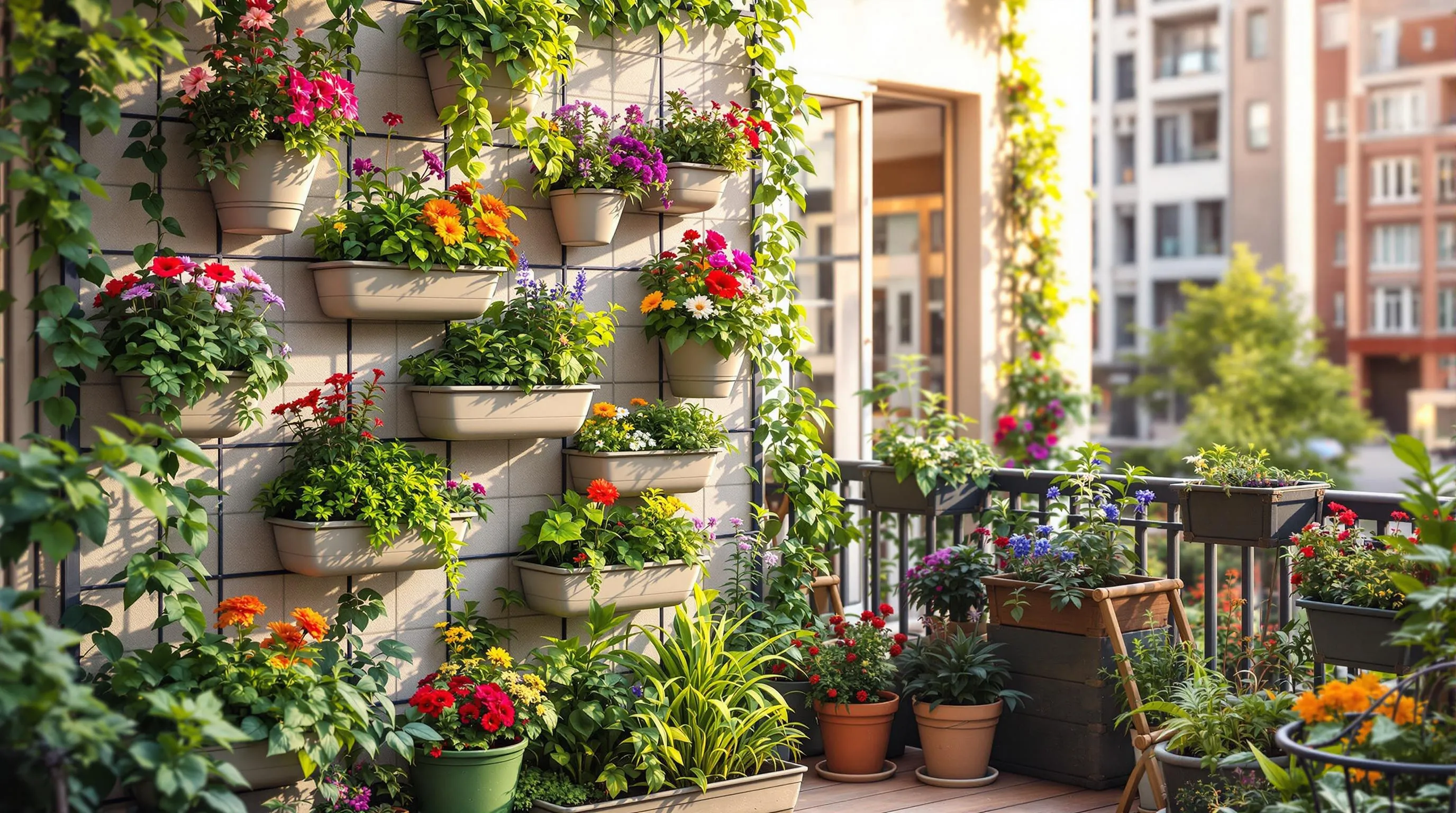
Vertical gardening maximizes your limited urban space by utilizing walls, fences, and vertical structures to grow plants upward rather than outward. This approach is perfect for city dwellers with minimal square footage who still want to create lush, green environments.
Wall-Mounted Planters and Living Walls
Wall-mounted planters transform blank vertical surfaces into thriving garden spaces. Install modular planting systems on exterior walls, fences, or balcony partitions to create striking visual displays. Pocket planters work exceptionally well for herbs and small flowering plants, while rigid panels can support a wider variety of vegetation. Living walls, also called green walls, offer a more comprehensive approach by covering entire surfaces with plants. These systems typically include built-in irrigation and can incorporate dozens of plant varieties in even the smallest spaces. For beginners, try starting with a simple wall-mounted grid system and plant-friendly species like pothos, ferns, succulents, or small herbs that won’t outgrow their containers quickly.
Trellises and Climbing Plants for Small Spaces
Trellises provide excellent support structures for vining plants in compact city gardens. Position free-standing trellises against walls or install wall-mounted versions to save even more space. Climbing plants like jasmine, clematis, and morning glories grow vertically with minimal footprint while producing beautiful blooms. For edible options, cucumbers, peas, beans, and certain squash varieties thrive on vertical supports and deliver harvests without consuming precious ground space. Even small balconies can accommodate trellis systems—try a diamond-pattern expandable trellis that adjusts to your available height. For apartment dwellers, window trellises installed on the exterior of windows allow climbing plants to create privacy screens while adding greenery to your view.
Container Gardening: Portable Urban Oases

Container gardening offers the perfect solution for city dwellers craving greenery without permanent garden space. These portable gardens allow you to create stunning plant displays that can move with you or adapt to changing conditions throughout the seasons.
Selecting the Right Containers for City Environments
Choose containers that match both your urban setting and the plants you’ll grow. Lightweight fiberglass or plastic pots work well for balconies with weight restrictions, while terra cotta provides better insulation for root systems but requires more frequent watering. Self-watering containers save time and ensure consistent moisture for busy urbanites. For small spaces, wall-mounted planters, railing planters, and stackable pots maximize your growing area. Consider drainage needs by selecting containers with built-in holes or adding your own, and place saucers underneath to protect surfaces. Repurposed items like wooden crates, metal buckets, or even old kitchen colanders can add character while promoting sustainability in your urban garden.
Best Plants for Container Gardens in Urban Settings
Select plants that thrive in containers and match your exact urban conditions. For sunny balconies or rooftops, try drought-tolerant herbs like rosemary, thyme, and lavender, or vegetables such as cherry tomatoes, peppers, and bush beans. In shadier locations, grow leafy greens like lettuce and spinach, or ornamentals such as hostas, ferns, and impatiens. Dwarf varieties of trees and shrubs—including citrus, Japanese maples, and boxwood—provide structure without outgrowing their containers. Combine plants with similar water and light requirements in shared containers, using the “thriller, filler, spiller” technique—tall centerpiece plants, mid-height fillers, and trailing varieties that cascade over edges. For year-round interest, incorporate evergreens or plants with colorful stems that remain attractive even in winter months.
Balcony Transformation: Maximizing Your Outdoor Nook
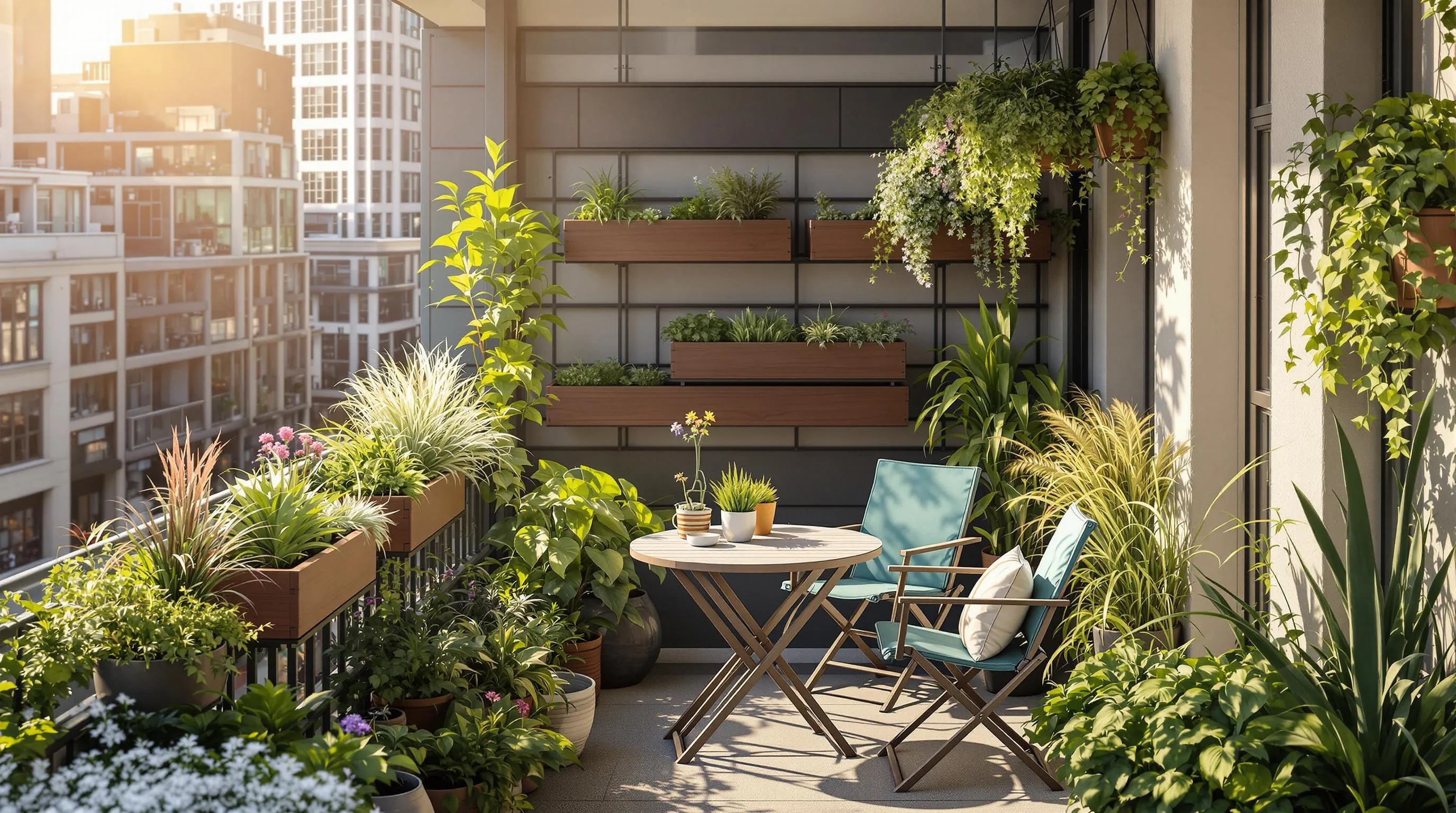
Even the smallest balcony can become a green sanctuary with thoughtful planning and design. Your urban outdoor space offers unique possibilities for creating a personalized retreat above the city streets.
Space-Efficient Furniture and Storage Answers
Transform your balcony with multi-functional furniture that maximizes every square inch. Opt for folding chairs and tables that can be tucked away when not in use, saving valuable floor space for plants and movement. Wall-mounted drop-leaf tables provide a convenient surface for coffee breaks or repotting plants without permanent footprint. Consider storage benches that offer both seating and hidden compartments for gardening tools, soil bags, and accessories. Vertical storage answers like pegboards can keep smaller tools organized and accessible while freeing up precious floor space. Stackable planters and tiered plant stands use vertical space efficiently, allowing you to grow more varieties without crowding. For truly compact spaces, invest in railing planters that hang on the outside of your balcony, creating garden space without sacrificing your walking area.
Weather-Resistant Plant Selections for Exposed Areas
Choose plants that can withstand the challenging conditions of balcony environments. Wind-resistant varieties like ornamental grasses, lavender, and rosemary feature flexible stems that bend rather than break in gusts. For sun-scorched balconies, drought-tolerant succulents, sedums, and Mediterranean herbs thrive with minimal water and maximum sunshine. In northern exposures or partially shaded areas, try hostas, ferns, and astilbes that flourish without direct sunlight. Consider seasonal protection strategies for your balcony garden, such as movable containers that can be repositioned based on weather conditions. Look for compact varieties specifically bred for container life—dwarf evergreens, miniature roses, and patio vegetables offer the beauty of their larger counterparts without outgrowing your space. Salt-tolerant plants like beach grass, Russian sage, and certain sedums make excellent choices for coastal balconies where salt spray can damage more sensitive species.
Rooftop Gardens: Elevating Your Urban Green Space
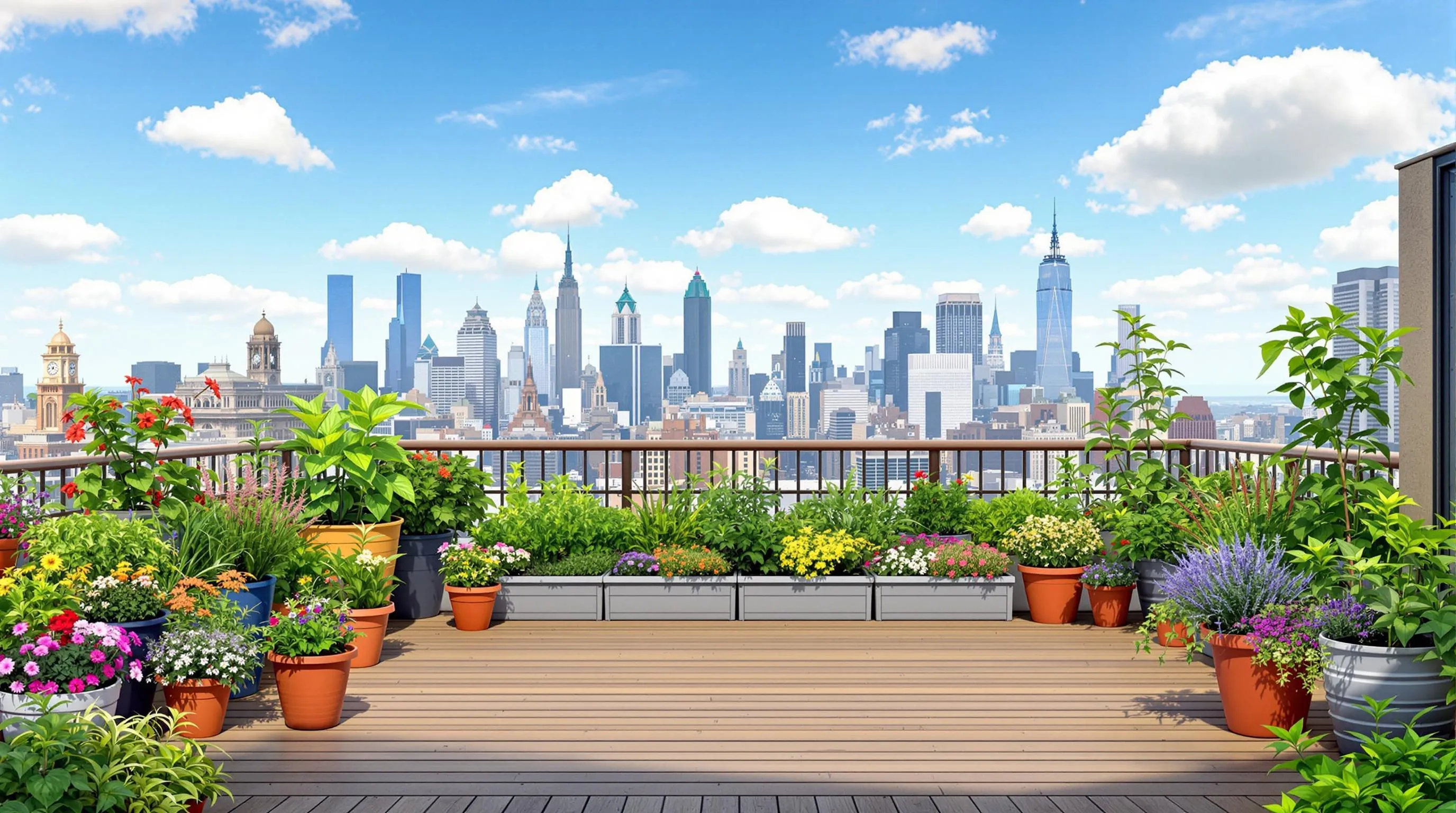
Rooftop gardens transform unused overhead spaces into vibrant green retreats while providing environmental benefits like improved air quality and reduced urban heat. They offer a unique opportunity to create a personal oasis above the busy city streets, maximizing your property’s potential.
Structural Considerations and Weight Distribution
Before creating your rooftop garden, consult with a structural engineer to determine your roof’s load-bearing capacity. Most residential rooftops can support 30-40 pounds per square foot, but this varies significantly based on building age and construction. Choose lightweight container materials like fiberglass, plastic, or specialized lightweight soil mixes to reduce the overall weight. Distribute planters evenly across the surface rather than clustering them in one area to prevent structural stress. Install modular decking systems that elevate containers slightly above the roof surface, which protects your roofing materials and improves drainage. Remember to incorporate wind barriers or secure anchoring systems for planters and furniture, as rooftop environments experience stronger wind conditions than ground-level gardens.
Plant Varieties That Thrive in Rooftop Conditions
Select plants that can withstand the harsh rooftop environment characterized by intense sun exposure, wind, and temperature fluctuations. Drought-tolerant Mediterranean herbs like rosemary, thyme, and lavender flourish in these conditions while requiring minimal maintenance. Native wildflowers and grasses have evolved to handle local climate extremes and attract beneficial pollinators to your urban network. Consider shallow-rooted succulents and sedums that need minimal soil depth and can survive periods of neglect. For edibles, try compact vegetable varieties like bush tomatoes, chili peppers, and dwarf fruit trees that produce high yields in container settings. Incorporate wind-resistant shrubs such as juniper, boxwood, or dwarf pine varieties along the perimeter to create protective microclimates for more delicate plants. During extreme weather, use row covers or portable greenhouse structures to extend your growing season and protect vulnerable specimens.
Community Garden Participation: Shared Urban Farming
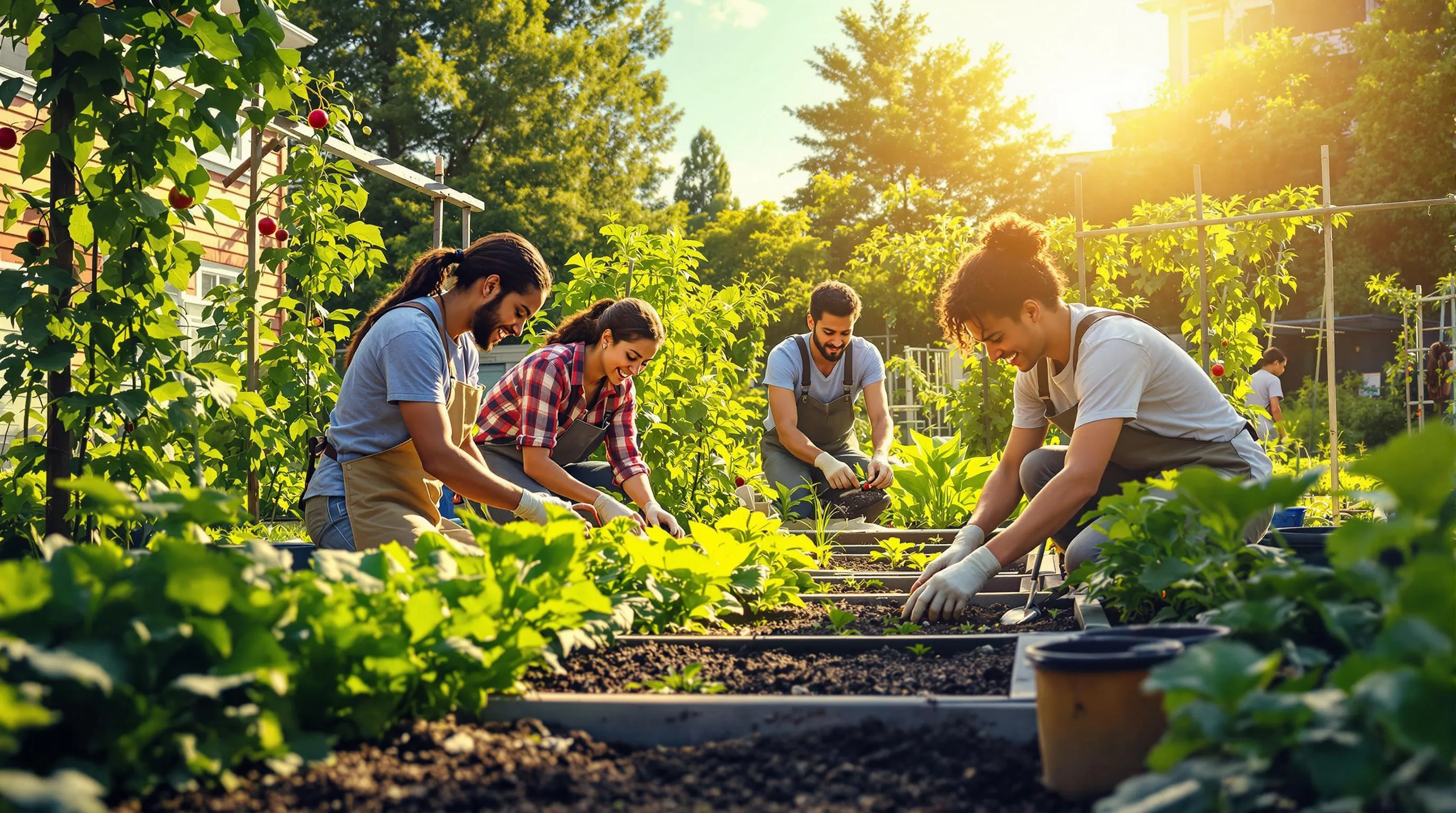
Community gardens offer a collaborative approach to urban farming, allowing city dwellers to cultivate larger plots than would be possible in individual spaces while fostering neighborhood connections.
Finding and Joining Local Community Gardens
Finding and joining a community garden starts with researching local options through municipal websites, neighborhood associations, or platforms like the American Community Gardening Association. Many cities maintain directories of active gardens with contact information for garden coordinators. Visit potential gardens during workdays to meet members and understand the garden’s culture before applying. Most community gardens have waiting lists, so apply to multiple locations to increase your chances. Membership typically requires annual fees ($20-100), volunteer hour commitments (10-20 hours per season), and adherence to community guidelines. Many gardens offer scholarship programs for those with financial constraints, making urban farming accessible to diverse community members.
Tips for Successful Community Garden Plots
Managing your community garden plot requires consistent attention and strategic planning. Visit your plot at least twice weekly during growing seasons to monitor plant health, water needs, and potential pest issues. Choose high-yield, space-efficient crops like tomatoes, peppers, and leafy greens that maximize your limited plot space. Carry out vertical growing techniques using trellises or cages to expand your growing area upward. Build relationships with fellow gardeners to share knowledge, tools, and excess produce—creating a supportive network that enhances everyone’s gardening experience. Contribute to communal areas by participating in workdays and helping maintain shared spaces like compost bins, tool sheds, and pathways. Consider succession planting to maintain continuous harvests throughout the season, replacing spent crops with new seedlings to maximize your plot’s productivity.
Urban Vegetable Gardens: Growing Food in the City
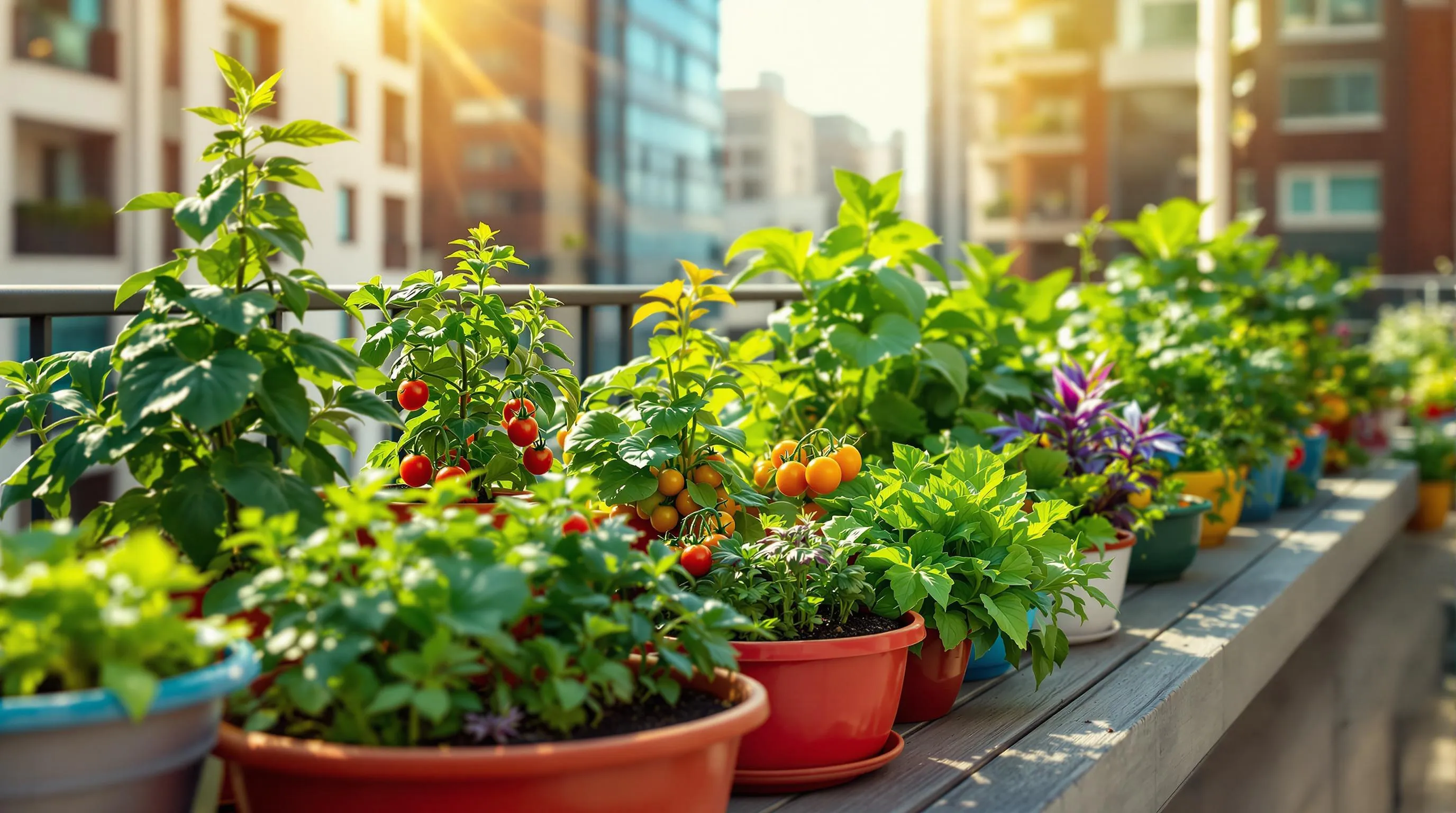
Transform your city space into a productive oasis by growing your own vegetables right where you live. Urban vegetable gardens offer a sustainable way to access fresh, organic produce while connecting with nature in concrete surroundings.
Space-Efficient Vegetable Varieties for Urban Gardens
Choose compact vegetable varieties specially bred for small spaces to maximize your urban garden’s productivity. Cherry tomatoes like ‘Tiny Tim’ and ‘Patio Princess’ thrive in containers and produce abundant harvests without sprawling. Bush varieties of zucchini and cucumbers save important space compared to their vining counterparts while delivering similar yields. Try ‘Spacemaster’ cucumbers or ‘Eight Ball’ zucchini for contained growth habits. Leafy greens such as kale, spinach, and arugula offer excellent space efficiency—harvest outer leaves while plants continue growing for weeks of continuous production. For root vegetables, select round carrot varieties like ‘Paris Market’ or ‘Atlas’ that develop fully in shallow containers. Many herbs, including basil, cilantro, and mint, grow perfectly in small pots on windowsills, providing fresh flavors throughout the season while taking minimal space.
Companion Planting for Maximum Yield in Small Spaces
Maximize your urban vegetable garden’s productivity through strategic companion planting—growing complementary plants together for mutual benefits. Plant basil alongside tomatoes to improve flavor and repel pests, while marigolds deter nematodes and other soil-dwelling pests when distributed throughout your garden. Pair nitrogen-fixing beans or peas with nitrogen-hungry plants like leafy greens for natural soil enrichment. Create vertical layers by growing shade-tolerant lettuce beneath taller tomato plants, utilizing the same footprint for multiple crops. Position aromatic herbs like rosemary and thyme between vegetables to confuse pests with their strong scents. For container gardens, combine plants with similar water and light requirements—try the classic “Three Sisters” approach with compact corn varieties, bush beans, and miniature pumpkins in a large container. These companion planting strategies create diverse plant communities that resist pests, maximize space utilization, and boost overall harvest yields in constrained urban settings.
Window Box Wonders: Gardening Without a Balcony
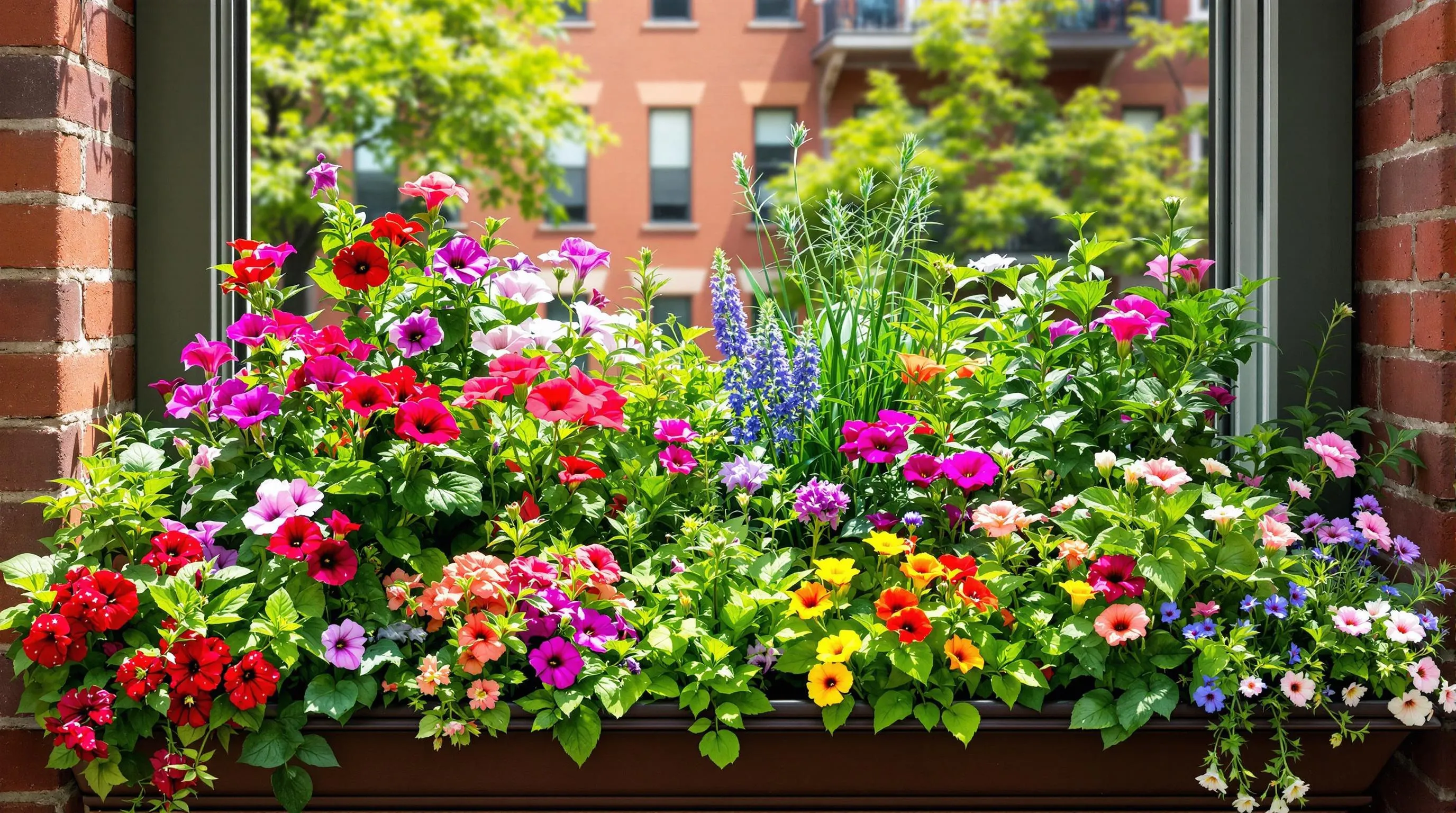
You don’t need a balcony, patio, or yard to create a stunning urban garden—window boxes offer a perfect solution for city dwellers with limited outdoor space. These compact containers transform ordinary windowsills into vibrant green displays while maximizing your minimal square footage.
Optimal Window Box Placement and Installation
Successful window box gardening starts with proper placement and secure installation. Choose south-facing windows for sun-loving plants like herbs and flowers, or north-facing windows for shade-tolerant varieties such as ferns and impatiens. Install your window boxes using sturdy brackets rated for the weight of soil, plants, and water—typically 30-50 pounds when fully planted. Leave a small gap between the box and window for air circulation to prevent moisture damage to your walls. Self-watering window boxes are ideal for busy urbanites, featuring water reservoirs that provide consistent moisture for up to a week. For rental properties, consider adjustable tension rod systems that don’t require drilling or opt for boxes that hang securely over the windowsill without permanent fixtures.
Seasonal Planting Schedules for Window Gardens
Maintain year-round interest in your window boxes by following a seasonal planting schedule. Start spring with cold-tolerant pansies, primroses, and early herbs like chives and mint. Transition to heat-loving petunias, geraniums, and compact vegetables like cherry tomatoes or peppers during summer months. For fall, switch to ornamental kale, chrysanthemums, and hardy herbs such as sage and thyme. Winter window boxes thrive with evergreen boughs, winter jasmine, and ornamental berries for color. Group plants with similar water and light requirements together, and use lightweight potting mix specifically formulated for containers to ensure proper drainage and nutrient retention. Refresh your soil annually and incorporate slow-release fertilizer at the beginning of each growing season to maintain vibrant displays throughout the year.
Micro-Gardens: Thriving in Ultra-Small Spaces
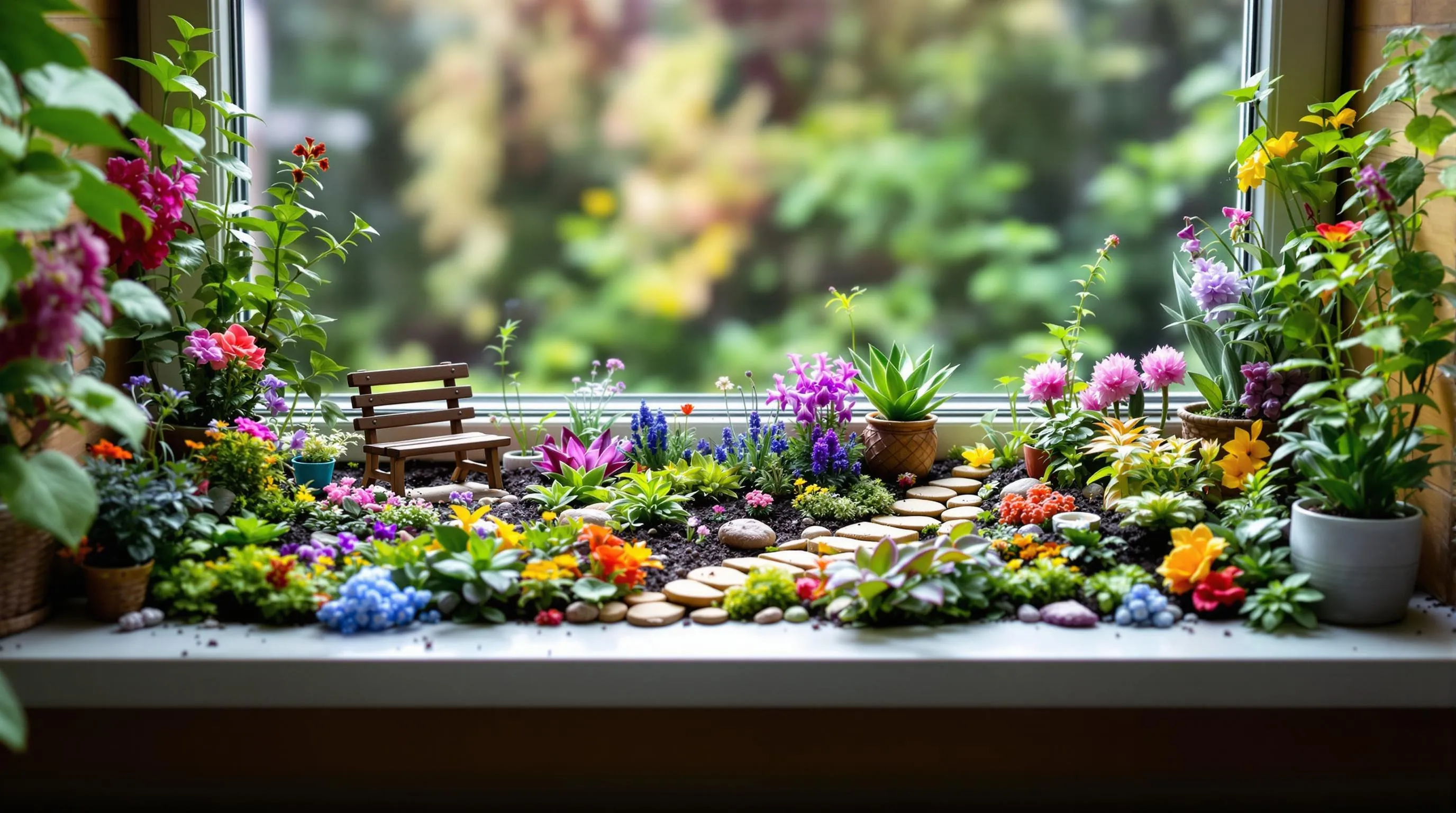
When space is extremely limited, micro-gardening offers innovative answers for urban dwellers who still crave greenery. These ultra-compact gardens can thrive in spaces as small as a windowsill corner or a tiny tabletop.
Miniature Plant Varieties Perfect for Tiny Gardens
The key to successful micro-gardening lies in selecting appropriately sized plants. Miniature varieties and dwarf cultivars are specifically bred to maintain smaller footprints while still delivering visual impact. Try fairy garden plants like mini African violets that rarely exceed 6 inches in diameter or dwarf succulents such as Haworthia and Echeveria that stay naturally compact. Herbs also offer excellent micro-garden options—look for compact varieties like ‘Spicy Globe’ basil or ‘Blue Boy’ rosemary that grow just 6-12 inches tall. For flowering options, consider dwarf zinnias, miniature daffodils, or tiny violas that provide color without excessive growth. Bonsai specimens create dramatic focal points while remaining perfectly sized for your smallest spaces, making them ideal centerpieces for tabletop gardens or windowsill displays.
Creating Visual Impact with Limited Square Footage
Maximize visual interest in your micro-garden by employing strategic design principles. Create depth by arranging plants at varying heights—place taller specimens at the back and gradually decrease heights toward the front. Incorporate contrasting textures by combining plants with different leaf shapes and sizes, such as pairing feathery ferns with smooth-leaved succulents. Add visual punch with strategic color placement—bright foliage or flowers command attention even in tiny spaces. Consider using miniature garden accessories like tiny benches, diminutive pathways, or scaled-down trellises to create the illusion of a complete industry in just a few square inches. For year-round appeal, include plants with different seasonal interest points, ensuring your micro-garden remains captivating regardless of season or available space.
Sustainable City Gardening: Eco-Friendly Approaches
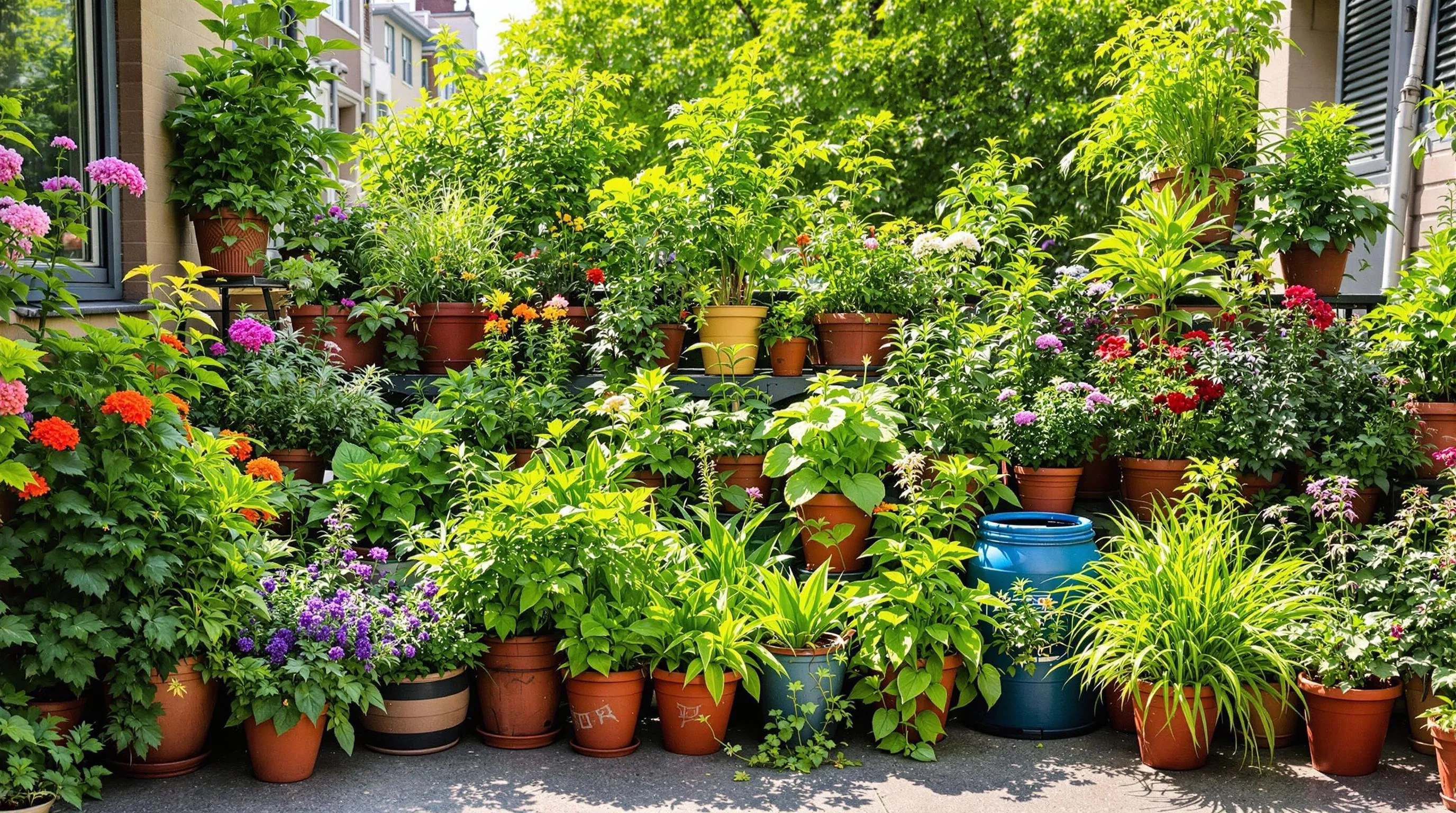
Urban gardening doesn’t just beautify your space—it can also help you reduce your environmental footprint. Implementing sustainable practices in your city garden creates a positive impact on both your local network and the planet as a whole.
Rainwater Collection and Efficient Irrigation Systems
Harness nature’s free resource by setting up a rainwater collection system for your urban garden. Install a compact rain barrel beneath downspouts on balconies or alongside container gardens to capture rainfall. These systems range from sleek designer models that complement modern aesthetics to DIY options using repurposed food-grade containers. Connect your collection system to drip irrigation lines that deliver water directly to plant roots, reducing waste by up to 70% compared to traditional watering methods. For smaller spaces, try self-watering containers with water reservoirs that provide consistent moisture while using significantly less water. These smart systems allow urban plants to thrive even during water restrictions and help reduce your utility bills while conserving precious resources.
Composting Answers for Apartment Dwellers
Transform kitchen scraps into garden gold with compact composting systems designed specifically for urban living. Bokashi composting bins use a fermentation process that’s odorless and perfect for under-sink storage, breaking down food waste (including meat and dairy) that traditional composters can’t handle. Vermicomposting with red wiggler worms offers another apartment-friendly option that converts organic matter into nutrient-rich castings in small, contained systems that can fit under counters or on balconies. For those concerned about maintenance, electric composters like the FoodCycler reduce volume by 90% and create usable soil amendment in just hours. Even freezing compostable materials until you can drop them at community collection points makes a difference. Using compost in your city garden closes the loop on food waste while reducing the need for chemical fertilizers, creating a truly sustainable urban growing system.
Urban Wildlife Gardens: Attracting Nature to the City
Your city garden can become more than just a green space—it’s a potential haven for urban wildlife. Creating biodiversity in your compact garden adds another dimension to your urban oasis while supporting local ecosystems.
Start small by incorporating native plants that provide food and shelter for local birds butterflies and beneficial insects. Even a tiny balcony can host pollinator-friendly flowers in containers or a small bird feeder.
Remember that your urban garden doesn’t need to be perfect or expansive to make an impact. Whether you’re cultivating vegetables on a rooftop transforming a balcony or simply adding window boxes you’re creating something meaningful. Each plant contributes to greener cities cleaner air and your personal wellbeing.
With creativity and the right approach any urban space can become a thriving garden that reflects your personality and enhances city living.







